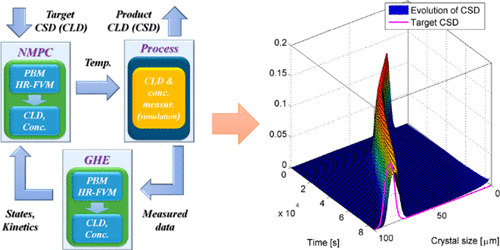当前位置:
X-MOL 学术
›
Ind. Eng. Chem. Res.
›
论文详情
Our official English website, www.x-mol.net, welcomes your
feedback! (Note: you will need to create a separate account there.)
Chord Length Distribution Based Modeling and Adaptive Model Predictive Control of Batch Crystallization Processes Using High Fidelity Full Population Balance Models
Industrial & Engineering Chemistry Research ( IF 3.8 ) Pub Date : 2018-02-23 00:00:00 , DOI: 10.1021/acs.iecr.7b03964 Botond Szilágyi 1, 2, 3 , Paul Şerban Agachi 3, 4 , Zoltán K. Nagy 1, 2
Industrial & Engineering Chemistry Research ( IF 3.8 ) Pub Date : 2018-02-23 00:00:00 , DOI: 10.1021/acs.iecr.7b03964 Botond Szilágyi 1, 2, 3 , Paul Şerban Agachi 3, 4 , Zoltán K. Nagy 1, 2
Affiliation

|
The control of batch crystallizers is an intensively investigated topic as suitable crystallizer operation can reduce considerably the downstream operation costs and produce crystals of desired properties (size, shape, purity, etc.). Nevertheless, the control of crystallizers is still challenging. In this work the development of a fixed batch time full population balance model based adaptive predictive control system for cooling batch crystallizers is presented. The model equations are solved by the high resolution finite volume algorithm involving fine discretization, which provides a high fidelity, accurate solution. A physically relevant crystal size distribution (CSD) to chord length distribution (CLD) transformation is also developed making possible the direct, real-time application of the focused beam reflectance measurement (FBRM) probe in the control system. The measured CLD and concentration values are processed by the growing horizon estimator (GHE), whose roles are to estimate the unmeasurable system states (CSD) and to readjust the kinetic parameters, providing an adaptive feature for the control system. A repeated sequential optimization algorithm is developed for the nonlinear model predictive control (NMPC) optimization, enabling the reduction of sampling time to the order of minutes for the one-day long batch. According to the simulation results, the strategy is highly robust to parametric plant-model mismatch and significant concentration measurement noise, providing very good control of the desired CLD.
中文翻译:

使用高保真全族平衡模型的基于弦长分布的批量结晶过程建模和自适应模型预测控制
分批结晶器的控制是一个深入研究的课题,因为合适的结晶器操作可以显着降低下游操作成本并生产出具有所需性能(尺寸,形状,纯度等)的晶体。然而,结晶器的控制仍然具有挑战性。在这项工作中,提出了基于固定批次时间全种群平衡模型的冷却批次结晶器自适应预测控制系统的开发。模型方程是通过涉及精细离散的高分辨率有限体积算法求解的,该算法提供了高保真度,精确的解决方案。还开发了物理相关的晶体尺寸分布(CSD)到弦长分布(CLD)的转换,从而可以直接,聚焦光束反射率测量(FBRM)探头在控制系统中的实时应用。增长的水平估算器(GHE)处理测得的CLD和浓度值,其作用是估算不可测的系统状态(CSD)并重新调整动力学参数,从而为控制系统提供自适应功能。针对非线性模型预测控制(NMPC)优化开发了一种重复的顺序优化算法,可以将一天的长批次的采样时间减少到几分钟。根据仿真结果,该策略对于参数化工厂模型失配和显着的浓度测量噪声具有很高的鲁棒性,可以很好地控制所需的CLD。增长的水平估算器(GHE)处理测得的CLD和浓度值,其作用是估算不可测的系统状态(CSD)并重新调整动力学参数,从而为控制系统提供自适应功能。针对非线性模型预测控制(NMPC)优化开发了一种重复的顺序优化算法,可以将一天的长批次的采样时间减少到几分钟。根据仿真结果,该策略对于参数化工厂模型失配和显着的浓度测量噪声具有很高的鲁棒性,可以很好地控制所需的CLD。增长的水平估算器(GHE)处理测得的CLD和浓度值,其作用是估算不可测的系统状态(CSD)并重新调整动力学参数,从而为控制系统提供自适应功能。针对非线性模型预测控制(NMPC)优化开发了一种重复的顺序优化算法,可以将一天的长批次的采样时间减少到几分钟。根据仿真结果,该策略对于参数化工厂模型失配和显着的浓度测量噪声具有很高的鲁棒性,可以很好地控制所需的CLD。针对非线性模型预测控制(NMPC)优化开发了一种重复的顺序优化算法,可以将一天的长批次的采样时间减少到几分钟。根据仿真结果,该策略对于参数化工厂模型失配和显着的浓度测量噪声具有很高的鲁棒性,可以很好地控制所需的CLD。针对非线性模型预测控制(NMPC)优化开发了一种重复的顺序优化算法,可以将一天的长批次的采样时间减少到几分钟。根据仿真结果,该策略对于参数化工厂模型失配和显着的浓度测量噪声具有很高的鲁棒性,可以很好地控制所需的CLD。
更新日期:2018-02-24
中文翻译:

使用高保真全族平衡模型的基于弦长分布的批量结晶过程建模和自适应模型预测控制
分批结晶器的控制是一个深入研究的课题,因为合适的结晶器操作可以显着降低下游操作成本并生产出具有所需性能(尺寸,形状,纯度等)的晶体。然而,结晶器的控制仍然具有挑战性。在这项工作中,提出了基于固定批次时间全种群平衡模型的冷却批次结晶器自适应预测控制系统的开发。模型方程是通过涉及精细离散的高分辨率有限体积算法求解的,该算法提供了高保真度,精确的解决方案。还开发了物理相关的晶体尺寸分布(CSD)到弦长分布(CLD)的转换,从而可以直接,聚焦光束反射率测量(FBRM)探头在控制系统中的实时应用。增长的水平估算器(GHE)处理测得的CLD和浓度值,其作用是估算不可测的系统状态(CSD)并重新调整动力学参数,从而为控制系统提供自适应功能。针对非线性模型预测控制(NMPC)优化开发了一种重复的顺序优化算法,可以将一天的长批次的采样时间减少到几分钟。根据仿真结果,该策略对于参数化工厂模型失配和显着的浓度测量噪声具有很高的鲁棒性,可以很好地控制所需的CLD。增长的水平估算器(GHE)处理测得的CLD和浓度值,其作用是估算不可测的系统状态(CSD)并重新调整动力学参数,从而为控制系统提供自适应功能。针对非线性模型预测控制(NMPC)优化开发了一种重复的顺序优化算法,可以将一天的长批次的采样时间减少到几分钟。根据仿真结果,该策略对于参数化工厂模型失配和显着的浓度测量噪声具有很高的鲁棒性,可以很好地控制所需的CLD。增长的水平估算器(GHE)处理测得的CLD和浓度值,其作用是估算不可测的系统状态(CSD)并重新调整动力学参数,从而为控制系统提供自适应功能。针对非线性模型预测控制(NMPC)优化开发了一种重复的顺序优化算法,可以将一天的长批次的采样时间减少到几分钟。根据仿真结果,该策略对于参数化工厂模型失配和显着的浓度测量噪声具有很高的鲁棒性,可以很好地控制所需的CLD。针对非线性模型预测控制(NMPC)优化开发了一种重复的顺序优化算法,可以将一天的长批次的采样时间减少到几分钟。根据仿真结果,该策略对于参数化工厂模型失配和显着的浓度测量噪声具有很高的鲁棒性,可以很好地控制所需的CLD。针对非线性模型预测控制(NMPC)优化开发了一种重复的顺序优化算法,可以将一天的长批次的采样时间减少到几分钟。根据仿真结果,该策略对于参数化工厂模型失配和显着的浓度测量噪声具有很高的鲁棒性,可以很好地控制所需的CLD。











































 京公网安备 11010802027423号
京公网安备 11010802027423号